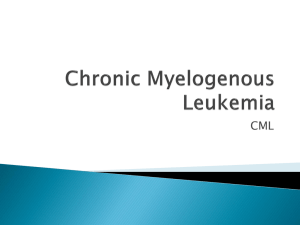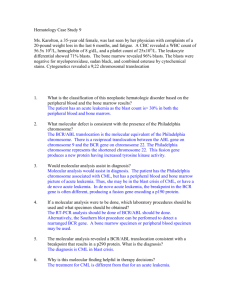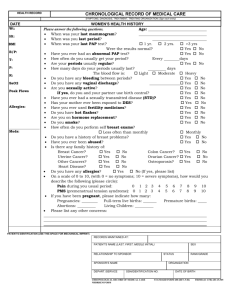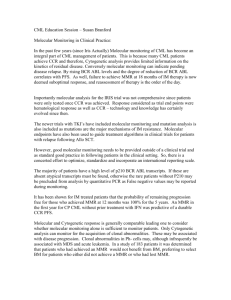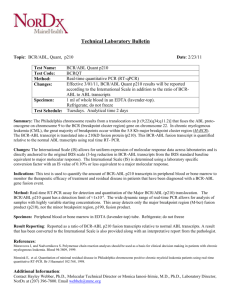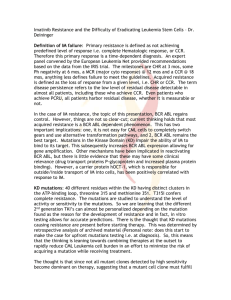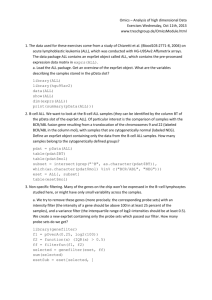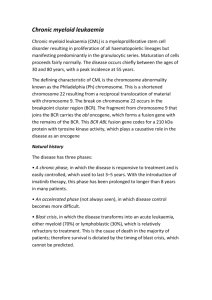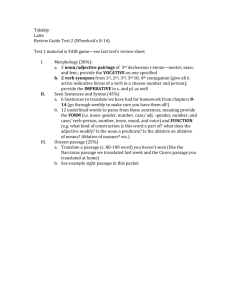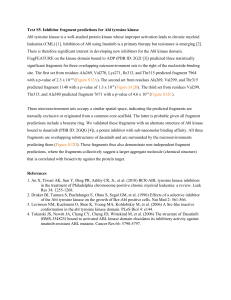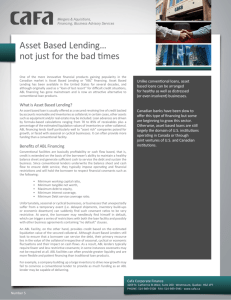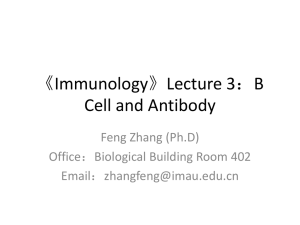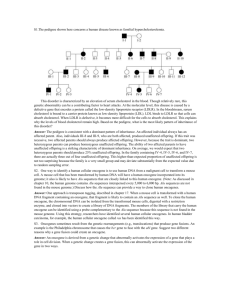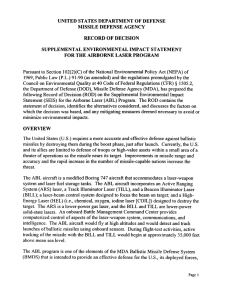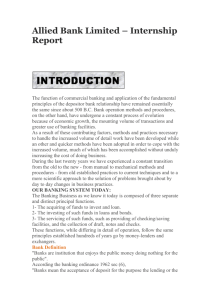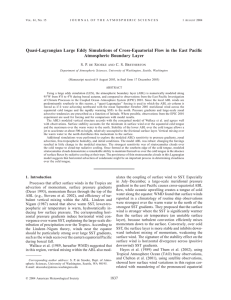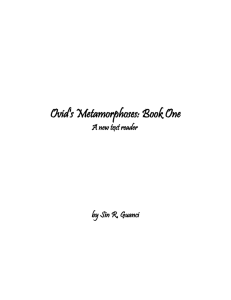Supplementary Information (doc 47K)
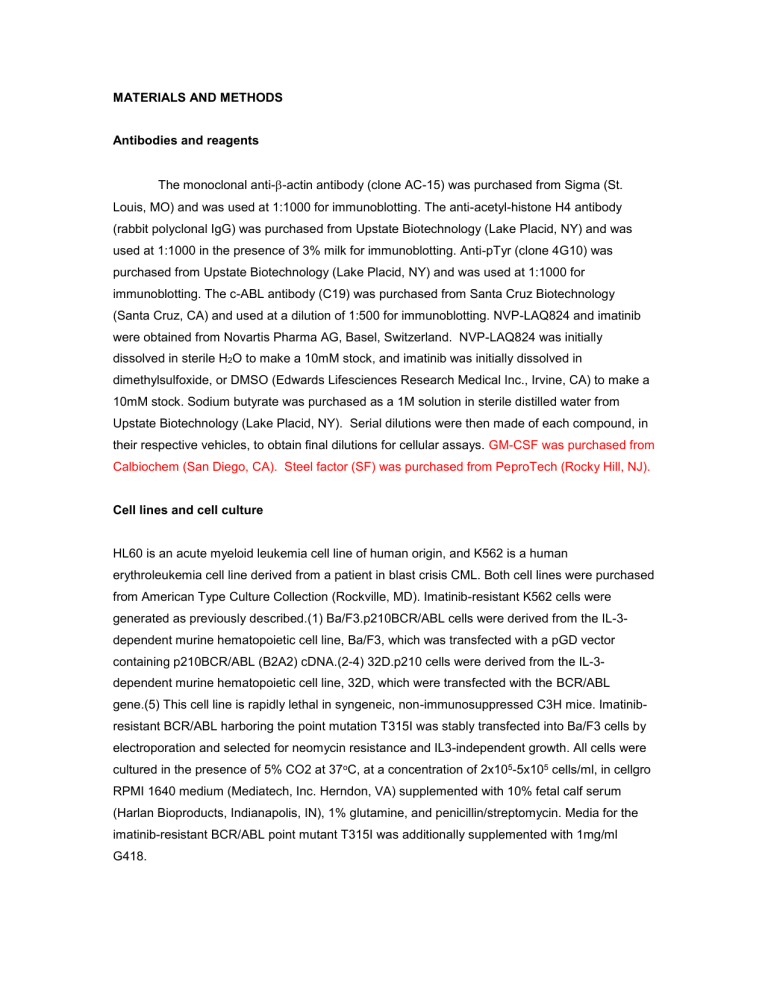
MATERIALS AND METHODS
Antibodies and reagents
The monoclonal anti-
-actin antibody (clone AC-15) was purchased from Sigma (St.
Louis, MO) and was used at 1:1000 for immunoblotting. The anti-acetyl-histone H4 antibody
(rabbit polyclonal IgG) was purchased from Upstate Biotechnology (Lake Placid, NY) and was used at 1:1000 in the presence of 3% milk for immunoblotting. Anti-pTyr (clone 4G10) was purchased from Upstate Biotechnology (Lake Placid, NY) and was used at 1:1000 for immunoblotting. The c-ABL antibody (C19) was purchased from Santa Cruz Biotechnology
(Santa Cruz, CA) and used at a dilution of 1:500 for immunoblotting. NVP-LAQ824 and imatinib were obtained from Novartis Pharma AG, Basel, Switzerland. NVP-LAQ824 was initially dissolved in sterile H
2
O to make a 10mM stock, and imatinib was initially dissolved in dimethylsulfoxide, or DMSO (Edwards Lifesciences Research Medical Inc., Irvine, CA) to make a
10mM stock. Sodium butyrate was purchased as a 1M solution in sterile distilled water from
Upstate Biotechnology (Lake Placid, NY). Serial dilutions were then made of each compound, in their respective vehicles, to obtain final dilutions for cellular assays. GM-CSF was purchased from
Calbiochem (San Diego, CA). Steel factor (SF) was purchased from PeproTech (Rocky Hill, NJ).
Cell lines and cell culture
HL60 is an acute myeloid leukemia cell line of human origin, and K562 is a human erythroleukemia cell line derived from a patient in blast crisis CML. Both cell lines were purchased from American Type Culture Collection (Rockville, MD). Imatinib-resistant K562 cells were generated as previously described.(1) Ba/F3.p210BCR/ABL cells were derived from the IL-3dependent murine hematopoietic cell line, Ba/F3, which was transfected with a pGD vector containing p210BCR/ABL (B2A2) cDNA.(2-4) 32D.p210 cells were derived from the IL-3dependent murine hematopoietic cell line, 32D, which were transfected with the BCR/ABL gene.(5) This cell line is rapidly lethal in syngeneic, non-immunosuppressed C3H mice. Imatinibresistant BCR/ABL harboring the point mutation T315I was stably transfected into Ba/F3 cells by electroporation and selected for neomycin resistance and IL3-independent growth. All cells were cultured in the presence of 5% CO2 at 37 o C, at a concentration of 2x10 5 -5x10 5 cells/ml, in cellgro
RPMI 1640 medium (Mediatech, Inc. Herndon, VA) supplemented with 10% fetal calf serum
(Harlan Bioproducts, Indianapolis, IN), 1% glutamine, and penicillin/streptomycin. Media for the imatinib-resistant BCR/ABL point mutant T315I was additionally supplemented with 1mg/ml
G418.
Normal bone marrow myeloid colony-formation assays
Bone marrow cells were obtained from normal donors after obtaining informed consent on an institutional IRB approved protocol. Mononuclear cells were isolated by density gradient centrifugation with Ficoll-Paque and diluted with IMDM media. A 0.5ml aliquot of cells at 2x10 5 cells/ml was combined with 0.5 ml BSA/NaHCO
3
(2.5 ml 10% BSA, 0.1 ml 7% NaHCO
3
), 0.5 ml
IMDM media supplemented with either vehicle or NVP-LAQ824 (to achieve final drug concentrations of 0.01 or 0.1
M, respectively), 2 ml Stempro 2.3% (StemPro-34; Life
Technologies, Gaithersburg, MD), 0.05ml 10mM 2ME (Sigma, St. Louis, MO), and 1.5 ml
FCS/IMDM media (1ml FCS, 0.5ml IMDM media supplemented with GM-CSF and Steel Factor , to achieve final concentrations of 20ng/ml and 1.5
g/
l, respectively). Samples were then incubated at 37 o C in the presence of 5% CO
2
for one week prior to counting the number of colonies formed in each treatment group. Magnetic bead-purified bone marrow CD34+ cells from a normal donor (>99% purity) were obtained from AllCells, LLC (Berkeley, CA).
AML cells
Discarded cells from diagnostic blood or marrow samples from anonymous patients with AML were obtained with an institutional review board (IRB) approved protocol. Cells were handled as outlined for normal bone marrow cells (above).
Cytotoxicity assays
The trypan blue exclusion assay was used to determine the number of viable cells in vehicle- and drug-treated samples. Cells were first stained with trypan blue (Sigma, St. Louis, MO), and then all unstained cells were counted using a hemacytometer. Cell concentrations were calculated as the number of cells x 10,000/ml, and cell viability was reported as the percentage of control
(vehicle-treated) cells.
Apoptosis assays
Cell viability and apoptosis in drug-treated cell populations were determined using the
Annexin-V-Fluos Staining kit (Boehringer Mannheim, Indianapolis, IN). Approximately 1x10 6 cells cultured in the presence of vehicle or drug were washed once with 1x phosphate buffered saline
(PBS) and pelleted by centrifugation for 5 minutes at 1500 rpm. Cells were resuspended in 100ul of 20% propidium iodide (PI) and 20% Annexin-V-fluorescein labeling reagent, either agent alone
(as controls), or were left unstained by diluting only in Hepes Buffer (as a control). All samples
were incubated for 10-15 minutes at room temperature, and then stained cells were diluted in 0.8 ml of Hepes buffer. Early apoptotic (annexin V+PI-) and late apoptotic/necrotic (annexin V+PI+) cells were enumerated by using the Epics cell sorter (Coulter).
Cell cycle analysis
Cell cycle analysis was performed after treatment with either NVP-LAQ824 or control media. Cells were centrifuged for approximately 5 minutes at 1500 rpm, washed 1x with PBS, fixed with 70% ethanol, treated with 10 mg/ml RNase (Roche Diagnostics Corp., Indianapolis, IN), then resuspended in 500
l of propidium iodide solution (50
g/ml propidium iodide, 0.1% NP-40,
0.1% sodium citrate), and cell cycle profile was determined using the program M software on an
Epics flow cytometer (Coulter Immunology, Hialeah, FL). Data were analyzed using the Phoenix flow system.
Western blot analysis
Cellular proteins were extracted by first lysing cells in 10% glycerol, 1% NP-40 (wt/vol),
0.1M NaF, 1mM phenylmethylsulfonyl fluoride, 1 mM sodium orthovanadate, 40
g/mL leupeptin, and 20
g/mL aprotinin. Lysates were placed on ice and vortexed 4-5 times over a 25-minute incubation period. Lysates were then centrifuged for 15 minutes at 12,000g, and supernatants were analyzed for protein concentration using the Bio-Rad Protein Assay (Bio-Rad Laboratories,
Hercules, CA). Equal quantities of protein were then dissolved in Laemmeli’s sample buffer by boiling for 5 minutes, and were then resolved on a sodium dodecyl sulfate (SDS)-15% polyacrylamide gel (for resolution of low molecular weight proteins) or an SDS-7.5% polyacrylamide gel (for resolution of moderate-high molecular weight proteins). Protein was then electrophoretically transferred to a Protran nitrocellulose transfer and immobilization membrane
(Schleicher and Schuell, Dassel, Germany). The membrane was blocked with 5% nonfat dry milk in 1x TBS buffer (10mM Tris-HCl, pH 8.0, 150mM NaCl) overnight at 4 o C, and then probed overnight at 4 o C with antibody in 1x TBST buffer (10mM Tris-HCl, pH 8.0, 150mM NaCl,
0.05%Tween20). After 3 washes for 5 minutes at a time with 1x TBST buffer, membranes were incubated at 25 o C for 1 hr with anti-rabbit immunoglobulin (horseradish peroxidase linked whole antibody from donkey), or anti-mouse immunoglobulin (horseradish peroxidase linked whole antibody from sheep) (Amersham Life Science, Inc., Arlington Heights, IL). After 5 washes for 5 minutes at a time with 1x TBST buffer, bound antibodies were detected with enhanced luminol and oxidizing reagent as specified by the manufacturer (NEN Life Science Products, Boston,
MA). A 30-minute incubation of filters at 50 o C in stripping buffer (2% SDS, 0.0625 M Tris, pH 6.8,
and 0.7% 2-mercaptoethanol) was carried out as a way to strip filters prior to probing with additional antibodies.
1. Weisberg E, Griffin JD. Mechanism of resistance to the ABL tyrosine kinase inhibitor STI571 in BCR/ABL-transformed hematopoietic cell lines. Blood
2000;95(11):3498-505.
2. Daley GQ, Baltimore D. Transformation of an interleukin 3-dependent hematopoietic cell line by the chronic myeloid leukemia-specific p210 BCR/ABL protein. PNAS 1988;85:9312-9316.
3. Sattler M, Salgia R, Okuda K, Uemura N, Durstin MA, Pisick E, Xu G, Li JL,
Prasad KV, Griffin JD. The proto-oncogene product p120CBL and the adaptor proteins
CRKL and c-CRK link c-ABL, p190BCR/ABL and p210BCR/ABL to the phosphatidylinositol-3' kinase pathway. Oncogene 1996;12(4):839-46.
4. Okuda K, Golub TR, Gilliland DG, Griffin JD. p210BCR/ABL, p190BCR/ABL, and TEL/ABL activate similar signal transduction pathways in hematopoietic cell lines.
Oncogene 1996;13(6):1147-52.
5. Matulonis U, Salgia R, Okuda K, Druker B, Griffin JD. Interleukin-3 and p210
BCR/ABL activate both unique and overlapping pathways of signal transduction in a factor-dependent myeloid cell line. Exp Hematol 1993;21(11):1460-6.
